Rights of way are footpaths, bridleways and byways which have public access. They are protected by law.
These paths are shown on a map and have a written description in a legal record called the Definitive Map and Statement
They also form part of Hertfordshire's Gazetteer.
How can rights of way be used?
Footpaths
The route of a footpath is shown by waymarks with yellow arrows.
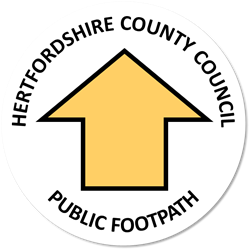
- You have the right to walk together with any ‘normal accompaniment’ (e.g. a dog, pram, wheelchair).
- You do not have the right to use a bicycle, or even to wheel a bicycle along them. This is not a criminal offence, but a trespass against the landowner.
- It is a criminal offence to drive a motor vehicle along a public footpath (unless you have a private right).
- You do not have the right to ride or lead a horse or take a horse-drawn vehicle along a footpath, although it is not a criminal offence.
Bridleways
The route of a bridleway is shown by waymarks with blue arrows.
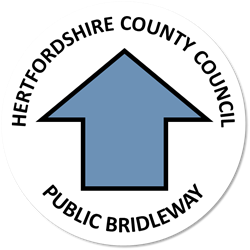
- You have the right to walk along them, to ride or lead a horse and to drive animals. You may also cycle along them (this right was granted under the Countryside Act 1968).
- Cyclists must give way to walkers and horseriders.
- It is a criminal offence to drive a motor vehicle along a bridleway.
- You do not have the right to take a horse-drawn vehicle along a bridleway, although it is not a criminal offence.
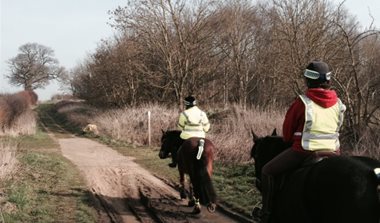
Restricted Byways
The route of a Restricted Byway is shown by waymarks with purple arrows.
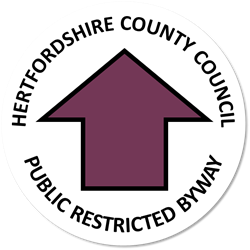
- Restricted Byways carry footpath and bridleway rights and may also be used by horse drawn carriage vehicles but not motor vehicles, motor bikes etc.
- Restricted Byway is a new type of right of way which was introduced by the Countryside and Rights of Way Act 2000 and brought into force by the Natural Environment and Rural Communities Act 2006.
- As a result 'Roads Used as a Public Path' have now been redesignated as Restricted Byways.
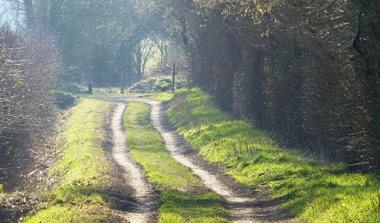
Byways Open to All Traffic (BOATs)
The route of a byway is shown by waymarks with red arrows.
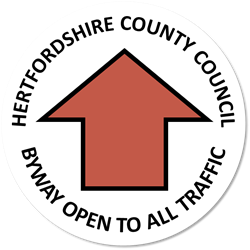
- BOATs carry footpath, bridleway and vehicular rights. They are normally unsurfaced.
- They carry identical public rights to surfaced country lanes but they are, by definition, used mainly by walkers and riders.
- A BOAT’s surface is maintained to a standard consistent with its usage. The law applies to BOATs in the same way as an ordinary public road - any vehicle must be fully taxed, MOT’d and insured and the driver must hold the appropriate driving licence. As a driver/rider you must also exercise the same level of care towards other users.
Permissive paths
Permissive routes may be shown by waymarks with white arrows, but not always.
- Permissive routes can be used by permission of the landowner. They are the responsibility of the landowner to maintain.
- Routes with permissive rights may or may not be signed accordingly.
- Permissive routes have no legal status and the landowner can remove the permission at any time.
- Permissive rights may exist over a public right of way. i.e permission for horse riders to use a footpath.
- The County Council is not responsible for permissive routes.
Roads Used as Public Paths (RUPPs)
This classification of route has now been replaced by Restricted Byway. Therefore motorised vehicle are now not allowed to use what were RUPPs.
RUPPs will now only appear on older maps. The route of a RUPP was shown by waymarks with black arrows.
- There were about 150 RUPPs in the county.
- They carried footpath and bridleway rights.
- They may or may not have carried vehicular rights.
- The Countryside and Rights of Way Act 2000 included a clause which redesignated all RUPPs as Restricted Byways.
Permanent Traffic Regulation Orders (PTROs)
In addition to the above classifications of Rights of Way, there are Permanent Traffic Regulation Orders (PTROs) which affect how some of these can be used.
Rights of Way Improvement Plan (RoWIP)
Our Rights of Way Improvement Plan 2017/18 - 2027/28 (PDF 917kb) helps local councils make local paths better for walkers, cyclists, equestrians (horse riders and horse and carriage drivers), and for people with disabilities.
The plan is part of the Local Transport Plan (LTP) to make travel safer and more sustainable. It also looks at biodiversity, community safety, culture and tourism, local economic needs, health, recreation and social inclusion.
How we develop the plan
To help us decide how to improve the paths on the Rights of Way network, we collect information from all over the county.
We look at:
- who uses the paths
- why people use the paths
- whether people know where to go on the paths
- how to get to the paths
- how easy the paths are to use.
We maintain a live database of this information, including suggestions and ideas, which you can view on the RoWIP webmap.
Maintenance
Drainage, surfacing, sign posting and way marking specifications
See details of public rights of way maintenance specifications:
The County Council's responsibilities
Definitive Map, obstructions and signposting
The County Council must:
- Keep the Definitve Map under continuous review and ensure it is available to the public.
- Maintain public rights of way and keep them free from obstruction.
- Signpost rights of way.
Maintenance of paths
The Rights of Way Service maintains:
- Non tarmac footpaths (FP)
- Bridleways (BR)
- Restricted Byways (RB)
- Byways Open to All Traffic (BOAT)
- Non tarmac Unclassified County Roads (UCRs - sometimes called Green Lanes/White Roads)
Hertfordshire Highways maintain:
- Cycleways
- Tarmac footpaths (FP)
- Footways (pavements)
- Tarmac Unclassified County Roads (UCRs)
Landowner's responsibilities
Obstructions and reinstatements
Landowners must:
- NOT obstruct the highway.
- Reinstate and clearly mark a ploughed up footpath or bridleway within 14 days. Any subsequent operations must be reinstated within 24 hours. You are not permitted to plough byways or restricted byways under any circumstances.
- NOT plough any route which runs along a field edge.
Landowner's guide to gates, stiles and other structures
You must get our permission to erect any type of structure on or across a public right of way. We may consider giving permission when:
- A public right of way crosses a field that contains (or will contain) livestock that can't be accommodated any other way.
- There is a public safety issue. These are dealt with on a case by case basis. If you think a safety issue will affect the type of structure you need, contact us for further advice.
- You want to upgrade an existing structure to a better or less-restrictive structure.
The law only allows a structure, such as a gate or a stile, to be erected on a footpath or bridleway. A structure can't be erected on a restricted byway or a byway open to all traffic.
It is our legal duty to improve access to the countryside for everyone, including those with mobility difficulties, so new stiles won't usually be suitable.
If you are granted permission to erect a structure across a public right of way the following conditions apply:
- You will be responsible for the cost of installing and maintaining the structure to the specified standards
- You must not erect any other type of structure other than the one you have permission for
- Gates on bridleways must be easy to open from horseback, bicycle and on foot
- If the conditions that allowed the structure to be erected change, you must remove the structure
- If the route is upgraded, you must reapply for permission for the structure
- If any of these conditions are not met then we will require the structure to be removed.
Once you have permission to erect a structure you have three choices:
- We will supply you with a technical drawing setting out the specifications for the structure and you can construct it yourself. Once it is built it will need to be inspected by a Rights of Way officer.
- You can pay us a fee to have a contractor erect the structure for you.
- You can pay us a fee to provide you with a structure kit and you can erect it yourself. Once it is built it will need to be inspected by a Rights of Way officer.
Landowner's guide to ploughing and cropping
If you have a public right of way crossing your land you have responsibilities to ensure:
- That the minimum width of the right of way is clear
- That there is nothing overhanging the path
- That the surface of the path is level and firm
The purpose of this information is to let you know:
- Which types of path you can and can not plough
- How you must restore a path if you do plough it
- The minimum width each type of right of way must be to ensure that it is passable.
User responsibilities
Motor Vehicle User Code of Conduct
Please keep the following Code of conduct in mind:
- Only use routes with motor vehicle rights - if in doubt check with the Rights of Way Unit at Hertfordshire County Council.
- Keep to the defined way across farmland - wheel can damage crops and grass, and driving or deviating from the route onto farmalnd is trespassing.
- Give way to walkers, horseriders and cyclists - as a courtesy on all narrow routes, stop and switch off engines if necessary. Take special care when driving near horses.
- Fasten gates to safeguard stock - except those tied open for farming purposes. An open gate invites animals to stray, endangering themselves, crops and traffic.
- Travel at a safe speed - ride/drive at a reasonable speed, taking regard of conditions and visibility.
- Ride and drive quietly - machines must be effectively silenced. Use the throttle with discretion as noise can offend.
- Follow the Countryside Code. Respect the countryside and those who live, work and play in it. Routes can be valuable habitats, so take special care in spring and early summer when wildlife may be rearing young.
Contact us
For Rights of Way problems, queries or suggestions please contact us by:
Phone: 0300 123 4047
Email: row@hertfordshire.gov.uk